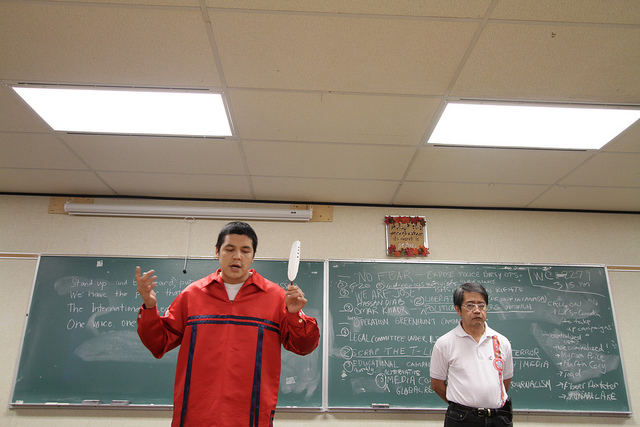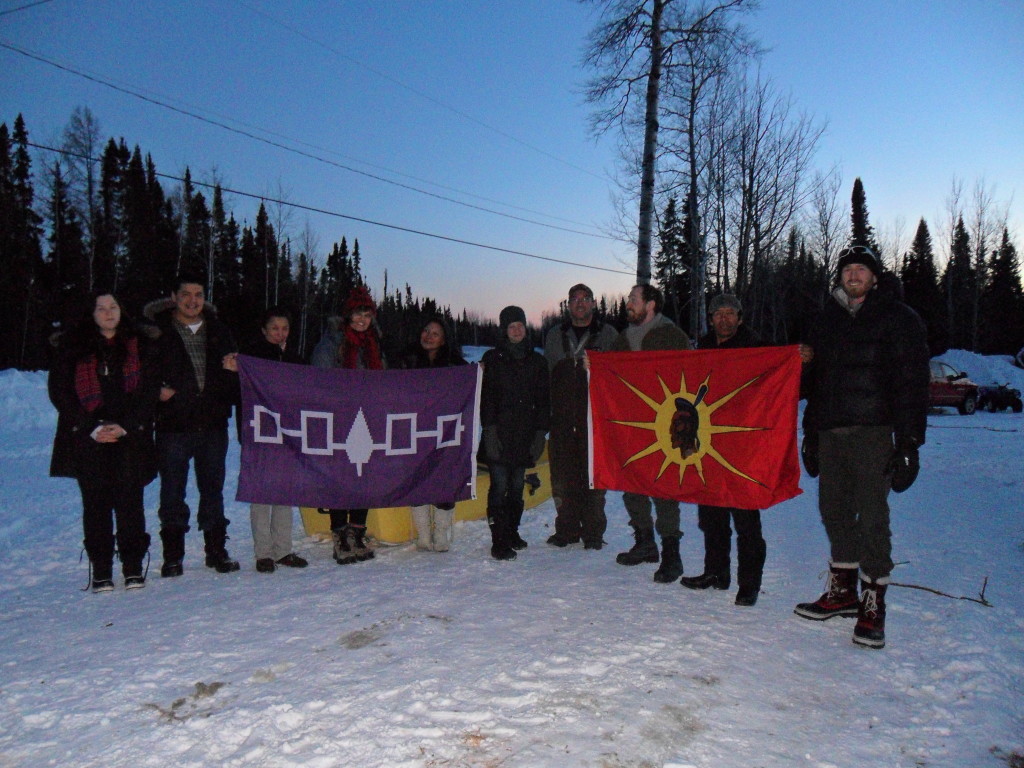
Giibwanisi (Anishinaabe Nation) and Chandu Claver (Igorot indigenous people, Cordillera, Philippines)
Giibwanisi describes the significance of the eagle feather. Dr. Chandu Claver, to his left, is the Chairperson of BAYAN Canada.
Photo by alex felipe (unedited) www.alexfelipe.info / www.alexfelipe.wordpress.com [email protected]
by ILPS-Canada Commission in Support of Indigenous People’s Struggles
For many years it has been clear that the struggles of Indigenous people represent a clear threat to Canadian capitalism and its state. Oka (1990), Gustafsen Lake (1995), Ipperwash (1995), Burnt Church (1999), and Caledonia (2006) have become place names symbolizing militant Indigenous resurgence. Each of these direct confrontations over land between the Canadian state and Indigenous people gained national and international attention and served to remind us that a major contradiction within Canada is the struggle of Indigenous people against colonialism.
In recent months, we have seen the birth of Idle No More (INM), a new movement for Indigenous land rights.
INM protests swept across Turtle Island over the past several months. Bridges, railways and highways were blocked, malls and intersections were filled with round dances, hundreds of teach-ins and public meetings took place, and the movement exploded on social media sites such as Twitter and Facebook. While the protest organizers sought to keep the movement firmly within pacifist boundaries, it is undeniable that INM has opened up new possibilities for resistance.
It is important to note that while the INM movement has captured the popular imagination and inspired a new generation of Indigenous activists and non-native supporters, grassroots traditionalists have long been active in resisting colonialism. Whether continuing to defend Kanonhstaton, the Six Nations reclamation near Caledonia, resisting border authorities in Akewesasne, or in blocking pipeline construction on Unist’ot’en lands in “British Columbia” and countless lesser-known struggles, grassroots Indigenous activists have “Never Been Idle.”
While INM was able to mobilize considerable resistance against Stephen Harper’s legislation, the movement faced significant shortcomings. The first of these came from the movement itself. Because INM was primarily focused around making moral claims and expressly limited itself to pacifism – going so far as to discourage nonviolent direct action such as occupations and blockades – it was going to be inevitably ineffective in struggling against a ruthless government that was deeply set in its ways and unwilling to budge. The Harper government was prepared to let Chief Theresa Spence starve on her hunger strike.
Because none of the actions carried out under the INM banner grew into the kinds of spectacular confrontations seen in Oka, Caledonia or elsewhere, the INM movement was able to fuel pan-Indigenous political consciousness but not repeal the government legislation being protested against. In part, this occurred because of a specific strategy undertaken by police forces to avoid confrontation with protesters and to allow the protest to “burn themselves out”.
Another key factor has been the relative weakness of forces on the Left and throughout other oppressed and exploited communities to connect with the grassroots struggles of Indigenous people. While many non-natives participated in INM activities, the explosion into activity of INM revealed how inadequate the relationships of the left are to those struggling in “Indian country”.
Fortunately, there are some indications that this dynamic is beginning to change. At the October 2012 General Assembly of International League of People’s Struggles (ILPS-Canada) in Toronto, delegates came together from some 20 organizations representing grassroots anti-imperialist forces. What was particularly significant about this conference was the level of participation from Indigenous activists from a variety of different communities and the links that they made with other oppressed and exploited communities fighting the same opponents.
One of the outcomes of the conference was the creation of the ILPS Commission in Support of Indigenous People’s Struggles. The mandate of the Commission was set to make serious and ongoing connections with Indigenous communities across Turtle Island in order to learn from their struggles, connect with international anti-imperialist struggles, jointly advance campaigns and altogether strengthen a united front against Canadian imperialism and colonialism.

February 2013: Members of the Commission in Support of Indigenous People’s Struggles in Sevant Lake, a few hours north of Thundery Bay.
In February 2013, ILPS organizers traveled to northern Ontario Indigenous territories, Savant Lake and Mishkeegomang, home to some members of the Commission.
Gary Wassaykeesic, Mishkeegomang delegate to the ILPS Commission, said:
“I wanted (ILPS organizers) to view some of the housing conditions, the severe overcrowding, the real conditions we live in… So it was a success because (they) came up and visualized everything I talk about… I hope it happens again… There’s a lot of potential now… I don’t think they made a crack in the door, I think (they) opened the door for other people, other organizations to come in and do what ILPS wants to do… And you’re coming into a community where that’s what people need right about now.”
If connections like these can continue to be forged between Indigenous peoples struggles and the grassroots people’s struggles across united within the ILPS and across Canada, then the alliance of anti-colonial and anti-imperialist forces can actually begin to turn the tide of attacks of Canadian colonialism, imperialism, and capitalism against the people. With greater unity, defeating pieces of legislation like Harper’s Bill C-45 Omnibus bill will be the least of our tasks.
For more about ILPS–Canada, visit: http://www.ilps-canada.ca.
Comments